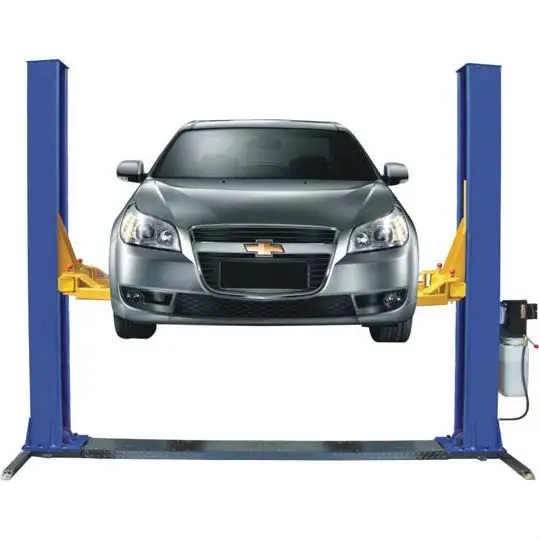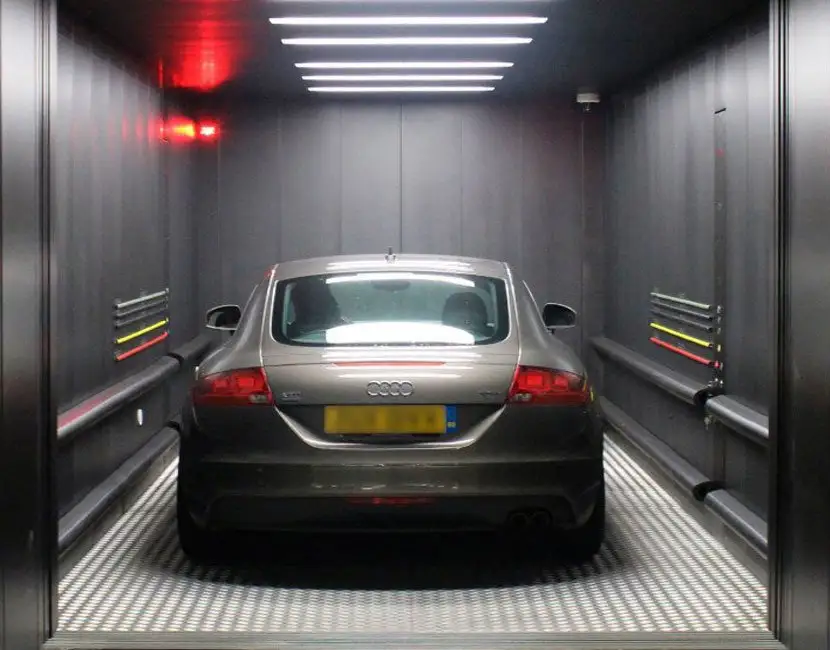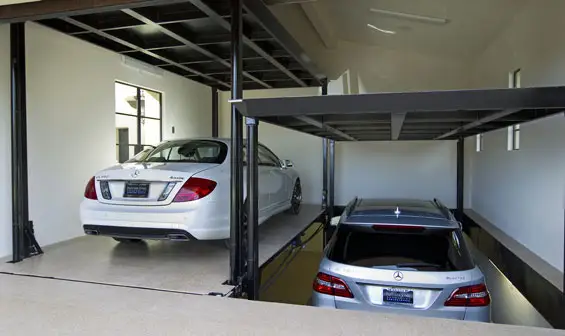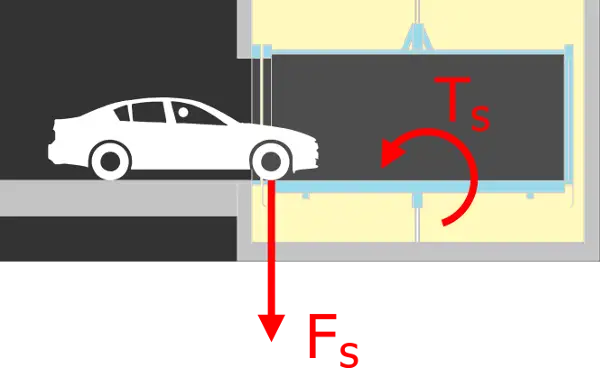A car elevator, also referred to as a vehicle elevator or automobile elevator, is a mechanism that transports vehicles between floors or levels of a building in a vertical direction. Here are some essential facts to familiarize yourself with about car elevators.
Types of Car Elevators
Car elevators have become increasingly popular in recent years, as more and more people are looking for efficient ways to store their vehicles. There are two main types to consider: traction and hydraulic. Let’s define what traction and hydraulic car elevators are.
Traction car elevators utilize cables and counterweights to elevate and descend, whereas hydraulic car elevators use the force of fluid pressure to perform the same action.
1)Hydraulic Car Elevators
Hydraulic car elevators use the force of fluid pressure to elevate and descend, to operate by using fluid, typically oil, to generate pressure that powers a piston to lift or lower the car. The piston is located within a cylinder, and as fluid is pumped into the cylinder, the piston moves upward, raising the car. Similarly, when fluid is released from the cylinder, the piston moves downward, lowering the car. Hydraulic elevators are typically used in low-rise buildings and have a maximum travel height of around 60 feet.

2) Traction Car Elevators
Traction car elevators utilize cables and counterweights to elevate and descend, traction car elevators, also known as cable-driven elevators, are a type of elevator commonly used in high-rise buildings to transport people and goods from one floor to another. They operate using a system of cables, pulleys, and counterweights to move the elevator car up and down. They are known for their fast and efficient operation, and they require a dedicated machine room at the top of the elevator shaft.

In summary, hydraulic car elevators are best suited for low-rise buildings, while traction elevators are more appropriate for high-rise buildings. The choice of elevator type depends on factors such as building height, available space, and budget.
New types of car elevators are being employed in different contexts, such as residential and commercial buildings, as well as for parking purposes.
A. Residential Car Elevator
A residential car elevator is designed to lift a car from the ground level to an upper level in a residential building. It is essentially a vertical lift that can accommodate a car, allowing homeowners to park their vehicles in a space-saving manner.
Residential car elevators come in various sizes and configurations, ranging from single-car lifts to multi-car lifts that can transport multiple vehicles at once. They can be installed in a garage, a driveway, or even outside a building, depending on the design and the location of the property.
Installing a residential car elevator can provide several benefits, including increased security for the vehicle, efficient use of space, and ease of access for people with mobility issues.

B. Car Parking Elevator
A car parking elevator is a mechanical device used to transport cars between different levels of a parking structure. These types of elevators are often used in multi-level parking garages or car showrooms where space is limited and maximizing parking capacity is crucial.
A car parking elevator typically consists of a platform or cage that can be raised or lowered using a hydraulic or electric motor. The platform is large enough to accommodate a car and is equipped with safety features such as brakes, sensors, and emergency stop buttons to ensure the safety of both the car and the occupants.
Car parking elevators can be designed to transport cars either vertically or at an angle, and they can be configured to accommodate various types of vehicles including sedans, SUVs, and trucks. They are often operated using a keycard or remote control system, and can be programmed to transport cars to a specific floor or location.

C. Commercial Car Elevator
A commercial car elevator is designed to transport vehicles between different levels of a commercial building, such as a 4S shop or a showroom. They are typically larger and have a higher weight capacity than residential car elevators.

How Much Does A Car Elevator Cost?
The cost of a car elevator varies depending on several factors, such as the type, size, weight capacity, and customization options.
In general, a basic car elevator with a weight capacity of up to 6,000 pounds will typically cost between $20,000 and $30,000. Nevertheless, elevators with higher capacity may exceed a price point of $50,000 or even more. Additionally, it’s recommended to consider that the installation expenses can have an impact on the final cost of the car lift. Depending on your location and the available space, installation may require additional construction work and customization. To get a more accurate estimate for your specific needs, it’s recommended that you obtain a quote from a reputable car elevator company.

What Is the Capacity of Car Elevators?
The weight capacity of a car elevator will depend on its design and specifications. car elevators can lift up to around 6600-11000 pounds or more, the speed is 0.25-0.5m/s. However, the weight capacity may also be limited by the building’s structure and foundation.
Car Elevator Dimensions
The dimensions of a car elevator can vary depending on a number of factors, including the size and weight of the cars being transported, the number of floors the elevator needs to travel between, and the available space within the building. When strategizing about a car lift, it’s important to take into account the following significant factors:
Platform Size
The platform size of a car elevator is the area on which the car will sit during transportation. The platform size should be large enough to accommodate the largest car that will be transported, with some additional space for maneuvering. Common platform sizes range from 8 feet by 20 feet to 10 feet by 26 feet, depending on the application.
Clearance Height
The clearance height of a car elevator is the distance between the platform and the ceiling of the elevator shaft. This dimension is important to ensure that cars can be loaded and unloaded safely and without damage. The clearance height should be at least 7 feet, and may need to be larger for larger vehicles.
Pit Depth
The pit depth of a car elevator is the distance between the bottom of the elevator shaft and the floor of the lower level. This dimension is important to ensure that the elevator can be installed safely and to provide enough space for the hydraulic components of the elevator. A typical pit depth is 8 feet, but this can vary depending on the design of the elevator.

Door Size
The door size of a car elevator is the width and height of the entrance to the elevator shaft. This dimension is important to ensure that cars can be loaded and unloaded safely and without damage. The door size should be at least as wide and tall as the platform and may need to be larger for larger vehicles.
Overall Height
The overall height of a car elevator is the distance from the floor of the lower level to the ceiling of the upper level. This dimension is important to ensure that the elevator can be installed safely and to provide enough clearance for the cars being transported. The overall height should be at least 12 feet, and may need to be larger for larger vehicles.
In addition to these key dimensions, there are many other factors to consider when designing and installing a car elevator, including building codes, safety requirements, and accessibility for maintenance and repairs.
Door Opening Modes
Multifold door structures are often used in car elevators to maximize the opening size of the elevator doors. These doors consist of multiple panels that fold or slide together when the doors are opened. The number of panels can vary depending on the size and design of the elevator, but typically there are at least four panels.
Additionally, the multifold door structure can be configured to allow for a variety of door opening modes, including:
- Center Opening: In this mode, the elevator doors open in the center of the elevator, providing a wide opening that is ideal for loading and unloading large vehicles.
- Side Opening: In this mode, the elevator doors open to one side of the elevator, allowing for vehicles to be loaded and unloaded from the side of the elevator.
- Split Opening: In this mode, the elevator doors split in the middle and open to both sides of the elevator, providing a wide opening that is ideal for larger vehicles.
- Telescoping Opening: In this mode, the elevator doors slide and overlap each other, creating a wide opening that can accommodate even larger vehicles than the other modes.

Installation and Maintenance
The installation and maintenance of a car elevator require specialized skills and expertise. It is essential to hire a professional installer and schedule regular maintenance to ensure the elevator’s safe operation.
Building Requirements
Building codes and regulations vary depending on the location and type of building where the car elevator will be installed.
Safety Features of Car Elevators
Like any other machinery, car elevators can pose certain risks if not used properly. Therefore, car elevators are designed with various safety features to prevent accidents and ensure safe operation. Some of the common safety features of car elevators are:
- Safety sensors: Car elevators are equipped with sensors that detect any obstruction in the path of the car. If an obstruction is detected, the elevator stops moving, preventing any potential collisions or accidents.
- Overload protection: Car elevators are designed with overload protection systems that prevent the elevator from operating if the weight limit is exceeded.
- Emergency stop buttons: Emergency stop buttons are installed in the elevator car and at the landing. In case of an emergency, anyone can press the button to stop the elevator immediately.
- Interlocking doors: Car elevator doors are interlocked, meaning that the car cannot move unless the doors are securely closed. This prevents the risk of anyone falling or being trapped in the elevator shaft.
- Backup power supply: Car elevators are equipped with backup power supply systems to ensure that the elevator can be operated during a power outage or other emergencies.
- Fire safety features: Car elevators are designed with fire-resistant materials, fire-rated doors, and fire suppression systems to prevent or contain any potential fire hazards.
- Regular maintenance: Regular maintenance and inspection of the car elevator are necessary to ensure that all safety features are working properly and the elevator is in good condition.
Conclusion
Improve your parking and boost your property’s worth with Dazen car elevators. Our elevators offer a top-notch solution for maximizing space, enhancing security, and increasing convenience. Reach out to us now to find out how our car elevators can transform the way you park your vehicles.
